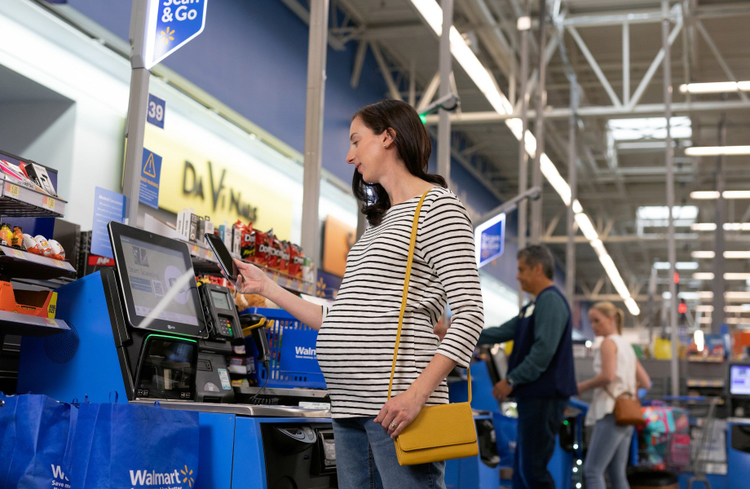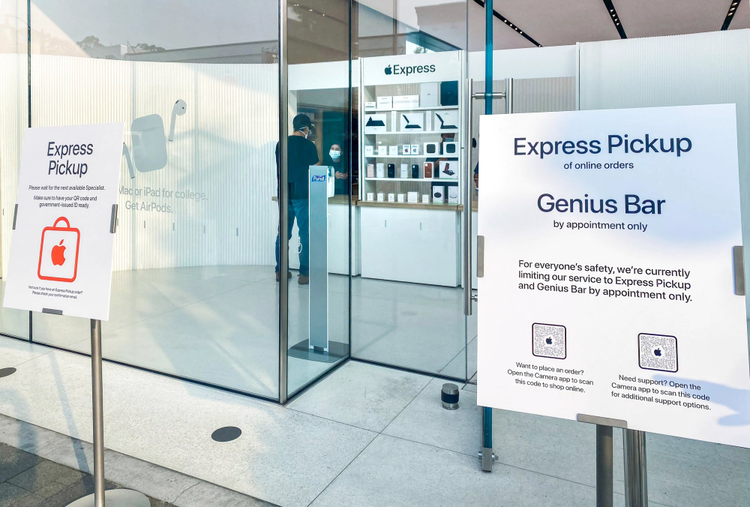Retailers are using these 5 technologies to reimagine shopping experiences amid COVID-19

Retailers are adopting a variety of technologies to enhance their holiday sales and customer experience strategies as consumers continue to cope with the major disruptions of the COVID-19 pandemic. Instead of luring people to malls and stores in the hunt for “door-buster” deals, merchants are focusing on ways to connect digitally and to provide contactless transactions for safety-conscious shoppers.
And while consumers have grown more comfortable with the idea of going to stores, the recent jump in coronavirus infections is likely to keep people on edge.
“We’ll see retailers try to give shoppers more confidence that they’ll have a safe and secure experience if they go to stores,” Michael Klein, global director of industry strategy and marketing for retail, travel and consumers goods at Adobe, said in an exclusive interview.
Amid the pandemic disruptions, retailers are using technology in five key ways given changing consumer needs.
1. Contactless mobile payments
U.S. consumers have been slow to adopt mobile payments compared with other regions, which leapfrogged ahead into cashless transactions.
However, the pandemic is motivating consumers to boost their usage of contactless payment methods, helping to limit physical contact with payment terminals that other people touch. Fifty-one percent of U.S. consumers said they’re now using some kind of contactless payment, including tap-to-go credit cards and mobile wallets like Apple Pay, Mastercard found in a survey. In addition, 51 percent of consumers say they’re using cash less often or not at all since the onset of the pandemic.
As the pandemic led to concerns about personal safety in stores, Walmart this year added contactless payments within its mobile app, while CVS Pharmacy upgraded its checkout experience to include touch-free service from PayPal and Venmo.

Walmart is taking preventative measures to keep its stores clean and to maintain a healthy environment. Image source: Walmart
“While mobile payments and contactless cards have accounted for a minority of payments in the past, the pandemic has clearly driven consumers to change their behavior and retailers to accelerate their adoption of the technology,” said Leon Buck, vice president for government relations, banking and financial services at the National Retail Federation.
2. Virtual experiences to supplement in-store activities
The pandemic has put a damper on in-store experiential marketing efforts, leading retailers to create a variety of digital experiences that can include augmented reality (AR) content, video games and livestreamed programming.
As a sign of the current climate, Macy’s this year announced for the first time in almost 160 years that its flagship store in New York City wouldn’t offer kids a chance to meet Santa Claus in-person. More than 200,000 kids typically visit the store for a chance to meet Santa in the month-long period before Christmas.
Instead, the storied department store chain plans to offer a virtual experience on its website called “Santaland at Home” starting on Nov. 27 and running through Christmas Eve. The experience will ask kids to get parental permission to start a virtual journey by train to the North Pole. It will include a look at Santa’s Village and Workshop and interactive games along the way. The journey ends with a chance to share holiday wish lists with Santa in an interactive video, and to snap a selfie with him.
Bloomingdale’s also plans to host an online event to showcase gifts and to raise money for charity. The department store’s Virtual Holiday Benefit will take place on Nov. 23 and support the Child Mind Institute, a nonprofit for children with mental disorders. In addition to BOPIS and BOPAC services, same-day delivery from DoorDash will be available during the holiday season on orders placed before a cutoff time.
Other brands are also creating virtual experiences to engage homebound consumers on their mobile devices. As one example, American Eagle is working with Disney on a holiday clothing collection that the apparel retailer is selling in an AR store on photo-messaging app Snapchat. Visitors to American Eagle’s profile page in the app can hold up their smartphones to look around its 3D virtual store and see products to order directly. Below is the video created to promote the collaboration.
Michael’s, the arts and crafts retailer, recently rolled out an online store on Pinterest, the social media platform that lets people create digital pinboards of photos. The experience lets Pinterest users explore three holiday-themed virtual rooms to find gift ideas, do-it-yourself projects, and make direct purchases online.
3. Online appointments to limit crowds
As much as retailers traditionally have wanted foot traffic in their brick-and-mortar stores, the pandemic has forced them to think about ways to use technology to help manage crowds.
Target, as one example, introduced dozens of safety measures this year, including limits on the number of people who are allowed in stores at the same time. Last month, the chain set up a web page that lets customers check on the wait times at its stores, and even make a reservation to hold a place in line. We’ll see more retailers offer this type of service during the holidays—and beyond.
“Our research tells us that guests still want to celebrate seasons and holidays, even as they acknowledge the things will be different in this new environment,” said Brian Cornell, chairman and CEO of Target, in a quarterly call. “We’ve also announced that we’ll be closing stores on Thanksgiving, sending a clear signal to guests that they won’t need to stand in line in crowded stores to get a great deal.”
Apple, which last month unveiled its latest line of iPhones later than usual because of pandemic-related delays in production, also has urged people to make appointments before visiting its stores. In anticipation of demand for its new products, the company began opening “Express” stores to help alleviate congestion. The pop-up stores are built in front of its main stores and have plexiglass partitions to protect customers visiting these sales counters that are stocked with accessories like phone cases and AirPods.

Apple quickly reimagined its in-store experience at the onset of the COVID-19 pandemic. Image source: 9to5mac.
“We believe that helps from the safety of our employee and the safety of the customer’s point of view, but still allows for an interaction to take place,” said Tim Cook, president and CEO of Apple. “We’ve also put a lot more people on the phones, because a lot more people are reaching out to us in that way.”
4. Seamless integration of ‘clicks and mortar’
Retailers for years have steadily given customers multiple ways to shop — whether through brick-and-mortar stores, websites or mobile apps — but the pandemic has acted as a major catalyst for a more seamless integration among those sales channels.
“We’ve taken a number of steps to mitigate both customer friction and financial impact,” Jeff Gennette, chairman and CEO of department store chain Macy’s, said in a quarterly conference call. “We’re optimizing inventory placement to meet customer demand wherever and however they shop.”
Those services not only include in-store shopping and endless aisle services, but buy online, pickup in store (BOPIS), buy online, ship-to-store (BOSS), buy online pickup at curbside (BOPAC) and “I can wait” delivery, he said. Macy’s also has “vendor direct” sales from its website to expand its merchandise assortment for home delivery or store pickup.
Retailers with buy online, pick up in-store fulfillment options (BOPIS) won Cyber Week 2019 and will continue to benefit from this offering during the 2020 holiday shopping season. Indeed, from April to May of this year, when the pandemic first hit, BOPIS orders grew 120 percent YoY.
Comparatively speaking, last holiday season BOPIS order growth reached 22 percent of online spend. Adobe expects this holiday season that BOPIS will reach over 40 percent YoY growth.
A critical part of these services is to provide customers with real-time information about what products are available for immediate pickup. That means integrating inventory management systems with customer-facing websites and mobile apps to engage shoppers who don’t want to wait for delivery.
“When we speak to consumers, they want visibility into real-time inventory; online and offline,” Adobe’s Klein said. “A key part of improving customer satisfaction is being able to show that information and fulfill an order.”
5. Chatbots gaining greater acceptance
Retailers continue to improve chatbot functionality to improve customer service while saving on labor costs. While chatbots for years had been criticized for their limited answers to customer questions, conversational commerce has improved with advancements in artificial intelligence (AI) and natural language processing (NLP) technologies.
Fast fashion retailer H&M, which first introduced a chatbot in 2016, this year expanded its efforts by integrating a virtual assistant and live chat service with Google Search and Google Maps. As a result, customers can find answers to questions about store hours, locations and item availability.
The integration helps H&M to provide a broader range of customer support to online shoppers who are likely to visit stores.
Because consumers are more likely to shop online during the pandemic, chatbots can help by performing a variety of tasks that ease pressure on customer service representatives (CSRs), such as gathering basic information from consumers.
Seventy-seven percent of consumers trust chatbots to take down name and address information, while 76 percent said they trust them to help choose products, according to a survey by LivePerson, a developer of conversational AI technology.
In developing a chatbot, it’s important that retailers manage consumer expectations about the technology and its current limitations to avoid disappointing customers.
“Using chatbots for holiday surges should be considered for very narrow purposes,” said Seth Earley, CEO of Earley Information Science. “If these are customer-facing, the bot needs to state up front and tell the user what it can do rather than say, ‘how can I help you?’ Open-ended questions put great demands on the bot.”